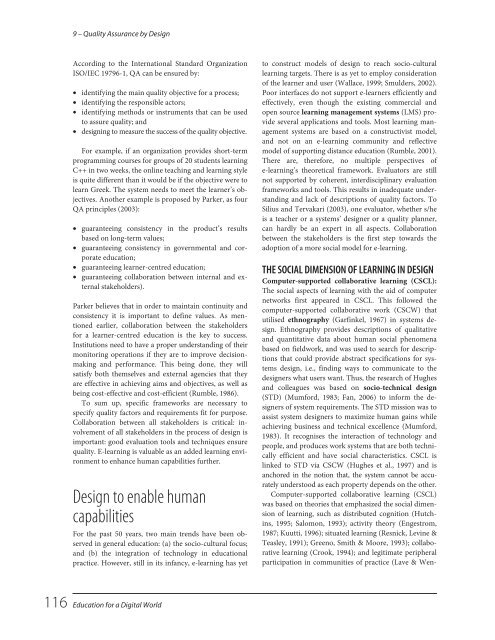Education for a Digital World Advice, Guidelines and Effective Practice from Around Globe, 2008a
Education for a Digital World Advice, Guidelines and Effective Practice from Around Globe, 2008a
Education for a Digital World Advice, Guidelines and Effective Practice from Around Globe, 2008a
Create successful ePaper yourself
Turn your PDF publications into a flip-book with our unique Google optimized e-Paper software.
9 – Quality Assurance by Design<br />
According to the International St<strong>and</strong>ard Organization<br />
ISO/IEC 19796-1, QA can be ensured by:<br />
• identifying the main quality objective <strong>for</strong> a process;<br />
• identifying the responsible actors;<br />
• identifying methods or instruments that can be used<br />
to assure quality; <strong>and</strong><br />
• designing to measure the success of the quality objective.<br />
For example, if an organization provides short-term<br />
programming courses <strong>for</strong> groups of 20 students learning<br />
C++ in two weeks, the online teaching <strong>and</strong> learning style<br />
is quite different than it would be if the objective were to<br />
learn Greek. The system needs to meet the learner’s objectives.<br />
Another example is proposed by Parker, as four<br />
QA principles (2003):<br />
• guaranteeing consistency in the product’s results<br />
based on long-term values;<br />
• guaranteeing consistency in governmental <strong>and</strong> corporate<br />
education;<br />
• guaranteeing learner-centred education;<br />
• guaranteeing collaboration between internal <strong>and</strong> external<br />
stakeholders).<br />
Parker believes that in order to maintain continuity <strong>and</strong><br />
consistency it is important to define values. As mentioned<br />
earlier, collaboration between the stakeholders<br />
<strong>for</strong> a learner-centred education is the key to success.<br />
Institutions need to have a proper underst<strong>and</strong>ing of their<br />
monitoring operations if they are to improve decisionmaking<br />
<strong>and</strong> per<strong>for</strong>mance. This being done, they will<br />
satisfy both themselves <strong>and</strong> external agencies that they<br />
are effective in achieving aims <strong>and</strong> objectives, as well as<br />
being cost-effective <strong>and</strong> cost-efficient (Rumble, 1986).<br />
To sum up, specific frameworks are necessary to<br />
specify quality factors <strong>and</strong> requirements fit <strong>for</strong> purpose.<br />
Collaboration between all stakeholders is critical: involvement<br />
of all stakeholders in the process of design is<br />
important: good evaluation tools <strong>and</strong> techniques ensure<br />
quality. E-learning is valuable as an added learning environment<br />
to enhance human capabilities further.<br />
Design to enable human<br />
capabilities<br />
For the past 50 years, two main trends have been observed<br />
in general education: (a) the socio-cultural focus;<br />
<strong>and</strong> (b) the integration of technology in educational<br />
practice. However, still in its infancy, e-learning has yet<br />
to construct models of design to reach socio-cultural<br />
learning targets. There is as yet to employ consideration<br />
of the learner <strong>and</strong> user (Wallace, 1999; Smulders, 2002).<br />
Poor interfaces do not support e-learners efficiently <strong>and</strong><br />
effectively, even though the existing commercial <strong>and</strong><br />
open source learning management systems (LMS) provide<br />
several applications <strong>and</strong> tools. Most learning management<br />
systems are based on a constructivist model,<br />
<strong>and</strong> not on an e-learning community <strong>and</strong> reflective<br />
model of supporting distance education (Rumble, 2001).<br />
There are, there<strong>for</strong>e, no multiple perspectives of<br />
e-learning’s theoretical framework. Evaluators are still<br />
not supported by coherent, interdisciplinary evaluation<br />
frameworks <strong>and</strong> tools. This results in inadequate underst<strong>and</strong>ing<br />
<strong>and</strong> lack of descriptions of quality factors. To<br />
Silius <strong>and</strong> Tervakari (2003), one evaluator, whether s/he<br />
is a teacher or a systems’ designer or a quality planner,<br />
can hardly be an expert in all aspects. Collaboration<br />
between the stakeholders is the first step towards the<br />
adoption of a more social model <strong>for</strong> e-learning.<br />
THE SOCIAL DIMENSION OF LEARNING IN DESIGN<br />
Computer-supported collaborative learning (CSCL):<br />
The social aspects of learning with the aid of computer<br />
networks first appeared in CSCL. This followed the<br />
computer-supported collaborative work (CSCW) that<br />
utilised ethnography (Garfinkel, 1967) in systems design.<br />
Ethnography provides descriptions of qualitative<br />
<strong>and</strong> quantitative data about human social phenomena<br />
based on fieldwork, <strong>and</strong> was used to search <strong>for</strong> descriptions<br />
that could provide abstract specifications <strong>for</strong> systems<br />
design, i.e., finding ways to communicate to the<br />
designers what users want. Thus, the research of Hughes<br />
<strong>and</strong> colleagues was based on socio-technical design<br />
(STD) (Mum<strong>for</strong>d, 1983; Fan, 2006) to in<strong>for</strong>m the designers<br />
of system requirements. The STD mission was to<br />
assist system designers to maximize human gains while<br />
achieving business <strong>and</strong> technical excellence (Mum<strong>for</strong>d,<br />
1983). It recognises the interaction of technology <strong>and</strong><br />
people, <strong>and</strong> produces work systems that are both technically<br />
efficient <strong>and</strong> have social characteristics. CSCL is<br />
linked to STD via CSCW (Hughes et al., 1997) <strong>and</strong> is<br />
anchored in the notion that, the system cannot be accurately<br />
understood as each property depends on the other.<br />
Computer-supported collaborative learning (CSCL)<br />
was based on theories that emphasized the social dimension<br />
of learning, such as distributed cognition (Hutchins,<br />
1995; Salomon, 1993); activity theory (Engestrom,<br />
1987; Kuutti, 1996); situated learning (Resnick, Levine &<br />
Teasley, 1991); Greeno, Smith & Moore, 1993); collaborative<br />
learning (Crook, 1994); <strong>and</strong> legitimate peripheral<br />
participation in communities of practice (Lave & Wen-<br />
116 <strong>Education</strong> <strong>for</strong> a <strong>Digital</strong> <strong>World</strong>


















